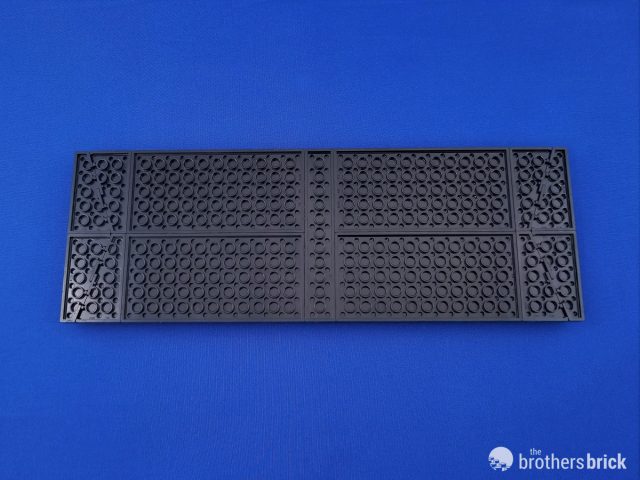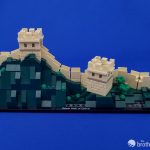The Great Wall is often cited as one of the wonders of the medieval world, at its peak stretching more than 5,500 miles across China. In LEGO form, 21041 Great Wall of China represents the oldest structure in the Architecture line and the first to include significant landscaping. It is also the first LEGO Architecture set designed to be modular, creatively constructed to connect multiple copies. The Great Wall includes 552 pieces and retails from LEGO for $49.99 USD. (EDIT: The set is currently on sale at Amazon.com for $39.99, making it easier to buy multiple copies.)
 The Great Wall is a departure from the Architecture sets of modern buildings and significant landmarks we have come to know and love, though it feels at home with its dark green and tan styling as well as its black tiled base. While similar in size to the 21006 White House, the Great Wall is hefty and designed to be viewed from all directions. The set was released earlier this year, but with the holidays coming up, we wanted to take a closer look.
The Great Wall is a departure from the Architecture sets of modern buildings and significant landmarks we have come to know and love, though it feels at home with its dark green and tan styling as well as its black tiled base. While similar in size to the 21006 White House, the Great Wall is hefty and designed to be viewed from all directions. The set was released earlier this year, but with the holidays coming up, we wanted to take a closer look.
The Box
As with other LEGO Architecture sets, the Great Wall comes in a premium black box featuring the model, some photographs as well as a somewhat architectural blueprint-style drawing of the set. In contrast to the complicated 21042 Statue of Liberty build aimed toward builders aged 16+, the Great Wall is a far more straightforward “studs on top” construction targeted to builders ages 12+.
There are five unnumbered bags inside the box as well as a perfect-bound instruction book. At first glance, the set includes more sizeable LEGO System bricks rather than many much smaller parts that Architecture sets have typically relied on to achieve their detailed looks or perhaps boost piece-counts (especially true in the Skyline series).
The instruction book contains 111 pages, printed against a black background. While the black pages help you feel like the set is a more of a luxury than LEGO’s standard light blue background, I take some issue since the black ink tends to show every smudge and fingerprint as you turn the pages. The book begins with several stunning photographs, some facts, and a timeline showing the history of the Great Wall of China, with the actual set instructions starting on page 23. Depending on the set version, the instructions come in two variants 1) English and Chinese, or 2) English, Spanish and French.
The build
The building process begins by crafting the base of the set out of black plates, though at the time I was confused why angled wedge plates were used on either end. Their purpose became apparent at the end of the build, but at the beginning I was befuddled and I was at a loss as to why 4×6 plates weren’t used instead. (I’ll go into detail why they are they at the end of the article.)
The base footprint is finished off with a simple latticework of bricks providing the foundation of the hills to come as well as some minor landscape detailing with clear 1×2 tiles representing water. Two black 1×8 printed tiles are included, one in English with the words “Great Wall of China” and one in simplified Chinese saying “长城” which translates to “Great Wall,” dropping the “of China” to more accurately represent how it is known locally. Since the completed set is beautiful from all angles, I opted to include both printed tiles centered on each opposing longer side, leaving one black 1×8 tile as a spare.
A plethora of dark green pieces are used to construct the stepped levels of the hill on the right. A small SNOT section (Studs Not On Top) will eventually be used to secure the wall portion to the base using an exposed ball joint.
The taller peak on the left is then built out of more dark green slopes, with a gap in the middle to insert the towers of the Great Wall when further along. This process is very straightforward, using only “studs on top building” which is why the set has a lower age suggestion. Each side of the hill is nearly an identical mirror build, making it even easier. (Of note, the 2x2x3 dark green slope is the first time the piece has been made in that color, and the set thankfully comes with 13 of them.)
With the entire base completed, we move onto the tan wall itself. Multiple sub-assemblies are created then used as puzzle pieces to form the sloped walkways with 1×2 panels representing parapets. The walkways are angled using clips and bars, with double-wide cheese slopes forcing the curved shape.
The tower is a simple build using a jumper and 1×1 plates to achieve the vertically-oriented rectangular windows beneath the battlement. The technique is then repeated to create crenelations on the top of the tower. The central core makes use of several modified 4×4 tan plates with the center 2×2 removed, another element recoloring exclusive to this set.
The second tower built is much like the first, with walkways attached to perpendicular sides rather than opposite ones like the first. The sub-assemblies feel solid and are in no way flimsy, using alternating hinge plates the achieve the gentle curve of the walkway, again using double-wide cheese slopes as spacers.
The final sub-assembly snaps onto the exposed ball joint, and with a few last trees and shrubs, the set is complete. Curiously, the instructions have the final staging showing the opposite side than the front of the box, but with this set there is no bad side and is meant to be viewed from all angles.
The finished model
Great Wall of China may be a straightforward set, but it is beautiful in its simplicity. It could be one of the faster LEGO architecture sets I have ever built, but it was still enjoyable, nonetheless. Though I am used to more complex building techniques and detailed models, I don’t think every set in the LEGO architecture line needs to be as extravagant.
In some ways, the Great Wall is a return to the original formula of LEGO Architecture sets, hearkening back to the dark green and tan sets of years gone by, even reaching back to the original 21005 Fallingwater set that started the whole product line.
With no apparent front or back, the set looks good from every direction, evoking the sprawling walkways of the Great Wall as it snakes across China. Some sections of the actual wall in China are indeed as steep as the set suggests.
I had the pleasure of hiking the Great Wall near Beijing earlier this year, and I can confirm that the look of the set is strikingly similar (albeit with slightly more intense greenery). You can only really appreciate the similarities between the actual Great Wall and the LEGO version by purchasing multiple copies.
Extending the set
Initially I was flummoxed as to why the designer used angled plates on the base of the set since they easily separate and once even popped off as I was moving and photographing the set. The reason is evident when you start to display multiple copies of the set to extend the length of the wall. Removing the black tiled border allows you to connect multiple sets end to end without a gap.
Connecting multiple copies of the set is where the Great Wall really shows off. I purchased an additional two sets, tripling the length of the wall to great effect. (I started with just one extra copy, but it looked too symmetrical. If you want to extend it for a more natural look, three or more is the way to go.)
It is rare when The Brothers Brick recommends purchasing a second copy of a set, and rarer still when we suggest getting three. But where the 21041 Great Wall of China set lacks in complexity, it gains exponentially in display value the longer it gets, transforming a simple set into a stunning model.
21041 Great Wall of China includes 551 pieces. The set is available from the LEGO Shop ($49.99 in the US | $64.99 in Canada | £44.99 in the UK), Amazon.com (on discount in the U.S. for $39.99 US at the time of writing) and elsewhere.
The LEGO Group sent The Brothers Brick a single copy of this set for review. Providing TBB with products for review guarantees neither coverage nor positive reviews.




















































Good for you, eating crow and putting your initial (inaccurate) complaints into the review. We’re all human!
And yeah… I can see purchasing several of these.
Very coincidental to see this article this morning.. I literally just built my second copy of this set last night. I totally agree that the display value gets exponentially better with multiple sets. Thinking of a third set now.. for the same reasons mentioned in the article.